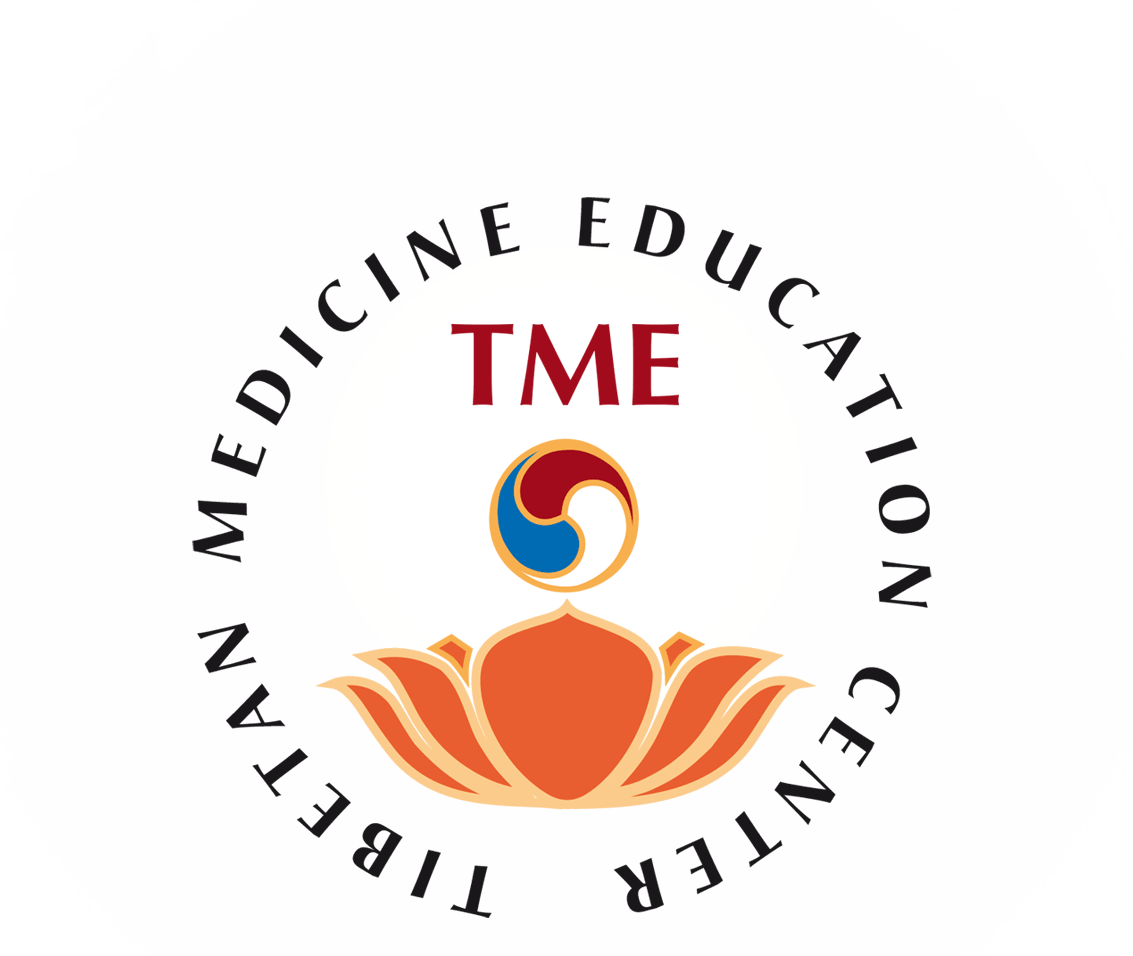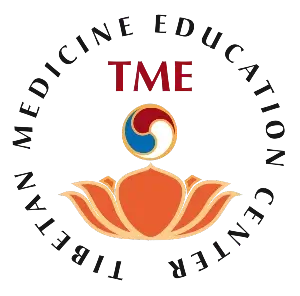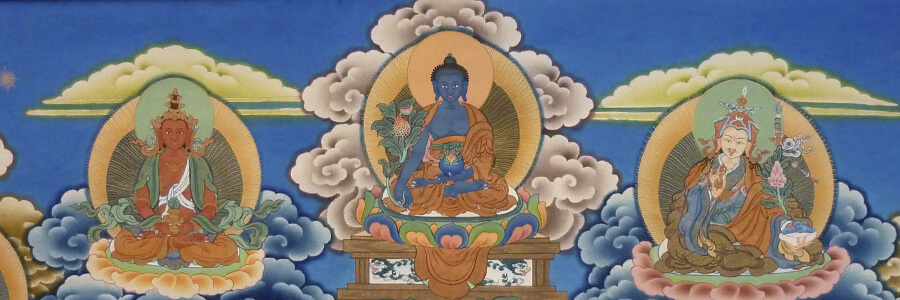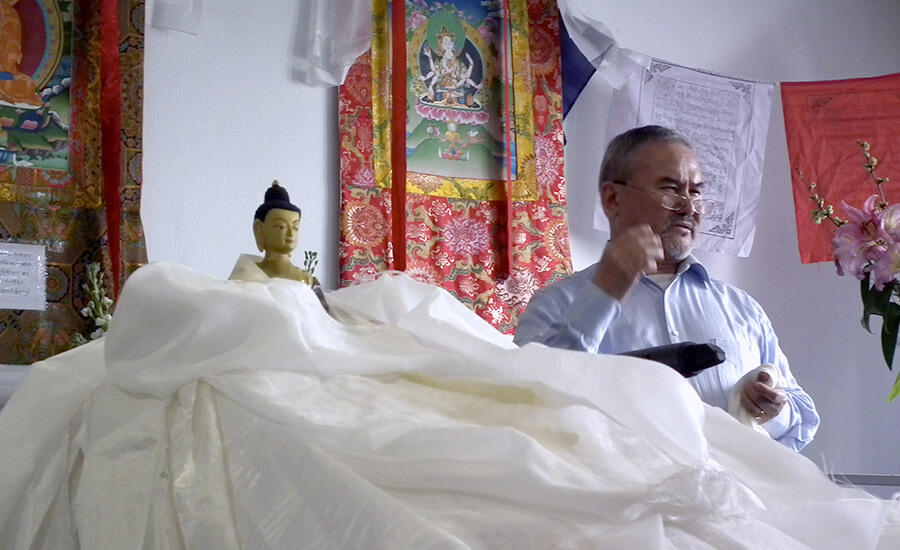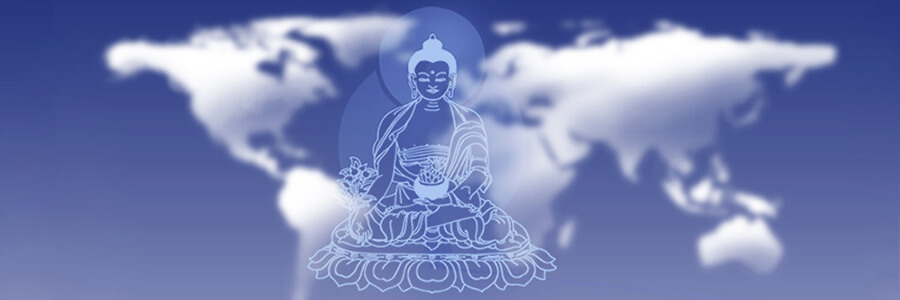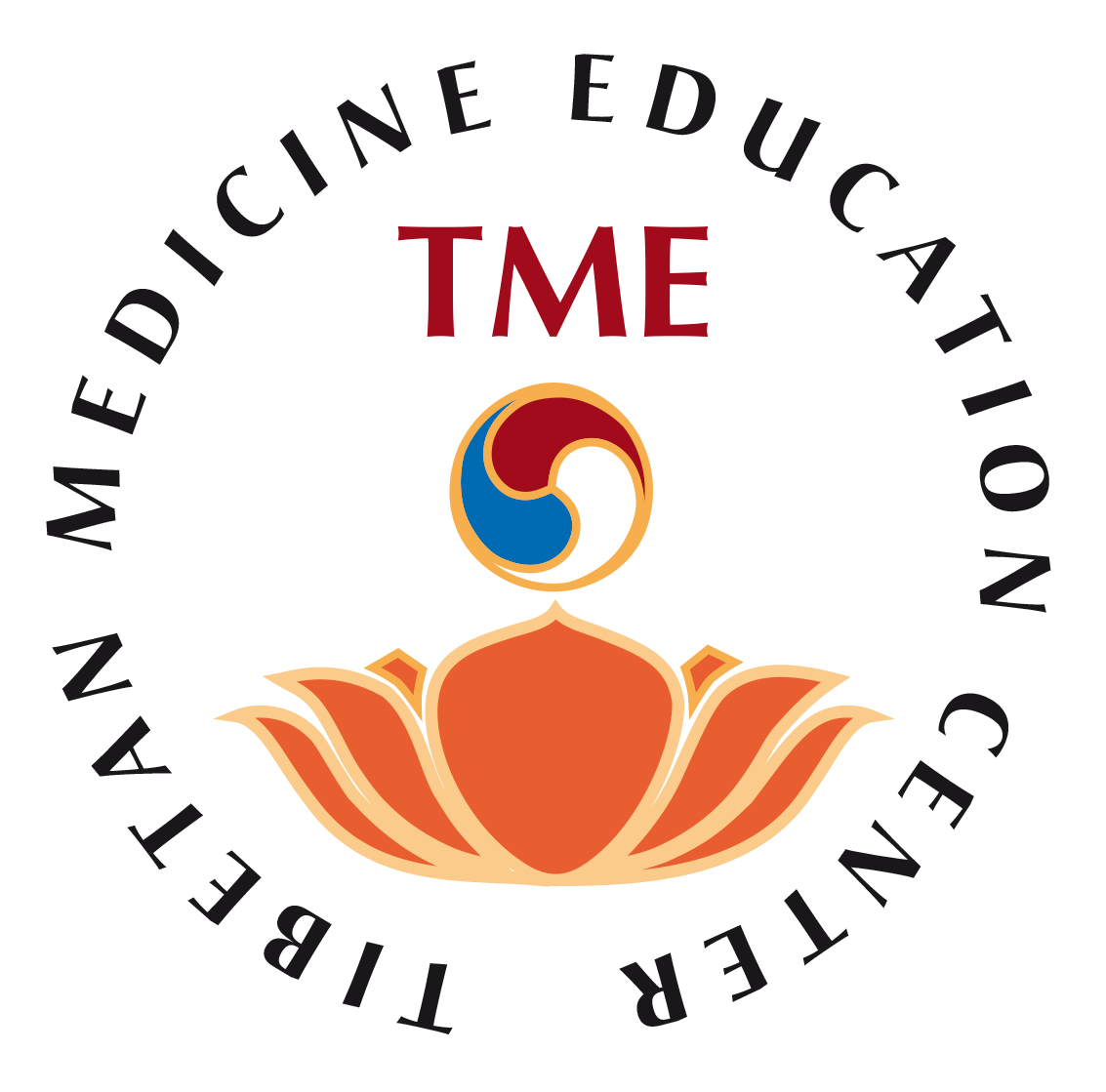Tibetan Medicine in the West
Thoughts of Western practictioners

By Carolyn Chan
This year marked the 10th anniversary of the Medicine Buddha retreat organized by the Buddha Bedurya Center in Milan and led by Dr. Pasang Yonten Arya. This milestone retreat was attended by men and women of varying backgrounds, most but not all being past or present students of Tibetan Medicine, and included a number of western trained healthcare practitioners. In the limited free time available, a few of these healthcare practitioners shared their personal experiences and views on Tibetan Medicine.
On May 5th, 2014, while the rest of Italy was starting a new work week, thirty-three retreatants, including myself, were starting a 7 day Medicine Buddha retreat in Odalengo Piccolo, a small town about 2 hours by car, north of Milan. This was the 10th year of this annual retreat, led by our revered teacher, Professor Dr. Pasang Yonten Arya, however I was a novice first-timer.
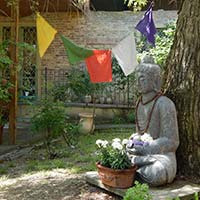 Nothing could have prepared me for this retreat. It has to be experienced, and each person’s experience is different. Without Medicine Buddha blessings and complete trust in the Retreat Master, I can see how difficult it could be to keep showing up at 5.30 every morning in the retreat hall. It takes courage too. After the first hour and a half of the first day spent sitting on a cushion on the floor in the retreat hall, with no end in sight, you start to notice your body complaining, itches, numbness and tingling in legs and toes, lower back pains, and wait… was that a mosquito? Once past this, the time flies by as you realize that these are possibly the most precious moments you have experienced so far in your life. There is no way to repay the kindness of our Teacher and Retreat Master, Dr. Pasang, who gave so generously of his wisdom and knowledge. But I deviate as this newsletter is not about the retreat.
Nothing could have prepared me for this retreat. It has to be experienced, and each person’s experience is different. Without Medicine Buddha blessings and complete trust in the Retreat Master, I can see how difficult it could be to keep showing up at 5.30 every morning in the retreat hall. It takes courage too. After the first hour and a half of the first day spent sitting on a cushion on the floor in the retreat hall, with no end in sight, you start to notice your body complaining, itches, numbness and tingling in legs and toes, lower back pains, and wait… was that a mosquito? Once past this, the time flies by as you realize that these are possibly the most precious moments you have experienced so far in your life. There is no way to repay the kindness of our Teacher and Retreat Master, Dr. Pasang, who gave so generously of his wisdom and knowledge. But I deviate as this newsletter is not about the retreat.
As I looked around the hall, I wondered at these courageous men and women who had put aside their everyday lives to come to this place, to stretch themselves at every level, and push past their personal limits. We were a mixed bag of persons of all ages and from diverse backgrounds. Interestingly, there were quite a few health care practitioners in attendance, all of whom were either past or present students of Tibetan Medicine. They were western trained healthcare practitioners, not all Buddhist practitioners, but learning Buddhist medicine, and opening their hearts and minds to Medicine Buddha on this retreat.
I asked a few of these healthcare practitioners for their views on the incorporation of Tibetan Medicine into their existing western style practice of medicine. I am grateful for their candid answers and willingness to sit with me and a translator in the limited free time we had available during the retreat. I claim responsibility and ask for forgiveness for any mistakes or errors in my understanding or in the translation. Many thanks to Silvia for her assistance with translation from Italian and Raul for translation from Spanish.
The healthcare practitioners unanimously agreed that there were aspects of Tibetan Medicine that they were utilizing in their practice of Western Medicine, and also that there were aspects or methods of practice of Tibetan Medicine that could be of general application by more medical practitioners and so be of benefit to a greater number of patients. The Tibetan Medicine holistic view of the body/mind connection and the natural state of the body, were particularly important to the healthcare practitioners interviewed, who integrated the knowledge relative to diagnosis and methods of treating different body constitutions, humors and elements, into their practice. It was also felt that the Tibetan Medicine external therapies were valuable tools, and teachings on dying, dissolution of the elements and the bardo, were useful to end of life patients.
So what does the future for Tibetan Medicine in Italy look like? The barriers to Tibetan Medicine were acknowledged by just about all the interviewees, the main one being the cultural gap. It appears however that there are two levels of barriers: one, by the Western Medicine fraternity, and the other by the patients themselves. The Western Medicine fraternity does not understand Tibetan Medicine and is sometimes prejudiced or hostile towards it, while many patients, steeped in the culture of avoiding pain, expect quick fixes from doctors for ailments. The interviewees also indicated some areas where Tibetan Medicine has great potential value within the Western Medicine establishment. The first is in the area of prevention of disease, the second is chronic disease treatment and cases where Western Medicine has not been successful, thirdly, patient end of life counselling, and fourthly, where the patient actively seeks alternative medicines to cure disease or is unwilling to suffer the side effects of Western Medicine.
The interviewees:
VICTORINE CUMERO (VC)
Medical Doctor, General practice and alternative medicines / Years in healthcare practice: 39 / Countries of practice: Belgium and Italy
SERGIO SPATAFORA (SS)
Medical Doctor, General practice / Years in healthcare practice: 26 / Country of practice: Italy
MATTEO BRAVI (MB)
Medical doctor, family medicine and general practice / Years in healthcare practice: 15 / Country of practice: Italy
RAUL ROMERO (RR)
Medical Doctor, Emergency Room/ Behavior Analyst / Years in healthcare practice: 17 / Countries of practice: Cuba, Spain, USA
LILIANA LILLIA (LL)
Nurse, ER, also works with terminal patients before palliative care stage / Years in healthcare practice: 33 / Country of practice: Italy
1(a) Is there a particular aspect/s or method/s used in Tibetan Medicine that could be incorporated effectively into your practice/specialty of Western Medicine?
VC:
Tibetan Medicine diagnostic methods and the knowledge bases for the prevention of disease, for example, by diet and cleansing of the body.
SS:
– The basic precept, to heal each person appropriately, according to their needs.
– External therapies such as Hor-Me, Ku-nye, Moxibustion
– Diagnostic methods such as pulse and tongue reading.
– Tibetan Medicine helped me to understand myself better, so that I could then help patients more.
MB:
Tibetan Medicine’s knowledge of the mind-body connection, relating the mental to the physical body health, and the 3 mental poisons as the cause of disease. In the west, disease is considered as a physical problem only, and the patients expect the doctor to do something about this problem. They want a pill to cure the disease and do not care how it was caused, even if it is because of their bad diet. The way to treat is to let the patient know that the cause is related to their mental attitude and get them involved in curing their disease.
Incorporates Tibetan Medicine knowledge of body constitutions in relation to the 3 humors in treatment.
RR:
– Buddhist counseling and psychological advice and the holistic approach to wellbeing, for example, diet, behavior, conduct for the patient’s constitution and humoral wellbeing.
– External therapies for Wind problems.
– Tibetan Medicine pharmacology. Tibetan Medicine for less extreme cases because there are fewer side effects, they are safer, and work well. There are some medicines that work very quickly.
LL:
– The spiritual aspect of Buddhism and the teachings relating to dissolution of the elements at time of death.
– External therapies: Ku-Nye for head and face, Hor-Me, Moxibustion
1(b) Do you believe your patients would be open to you using this aspect/s or method/s of Tibetan Medicine to treat them?
VC:
Many of my patients that have not had success with Western Medicine and so they are open to the alternatives offered.
SS:
Patients are open.
MB:
Integrates knowledge of Chinese and Tibetan Medicine in relation to energetic imbalances, but does not disclose this to patients. Some patients want to learn, they read about health and are more conscious, these patients are open.
RR:
Clients are advised that Eastern principles are being applied if they are open to it. Patients would be open to hearing about Tibetan Medicine as an alternative, or to the use of Western medicine in extreme cases and then to switch to Tibetan Medicine as the patient improves.
LL:
Patients understand and are open to it. They want advice on the bardo and afterlife. Cannot give the depth of spiritual advice like a lama, but still helpful.
2. Is there an aspect/s or method/s used in Tibetan Medicine that could be more widely used by other health practitioners in your field/specialty of medicine, and so benefit more patients?
VC:
It is generally good to integrate. It would be good to incorporate the Tibetan Medicine external therapies (Moxibustion, Hor-Me, etc.), meditation, energetic therapy, diet based on constitution and seasons and taking care of patient in a holistic way. The Tibetan Medicine teaching regarding the different constitutions and three humors is easy to translate into western understanding and is something that Western Medicine is interested in learning about.
Western Medicine is interested in the Tibetan Medicine view of the mind/body connection and the Tibetan Medicine ways of treating patients.
We can adopt the gentle manner of taking care of patients, especially the important handling of the patients’ end of life.
SS:
It would be good to have more widespread usage of the diagnostic methods, as well as the adoption of a more holistic view of the problems of patients.
MB:
Herbal medicines, Moxibustion, Acupuncture
RR:
There should be more widespread application. Presently being adopted and used where patients have chronic diseases, difficult cases, where Western Medicine is not working or giving good results.
LL:
– Guidance on the mind/body connection is very useful and Western Medicine does not have the understanding.
– Dream prognostication. Western medicine only focuses on the physical, and sees dreams as unrelated to reality. Tibetan Medicine understands dreams and using for diagnosis. Patients are interested in this.
– Counselling for emotional problems and removing the cause of the disease.
– Holistic view of health, considering the constitution, humors and mental poisons. Tibetan Medicine integrates everything.
– Western Medicine is better where immediate effects are needed. Tibetan Medicine is useful, not just for the external, but the internal, the body/mind.
3. How do you see the benefits of Tibetan Medicine being incorporated into Western Medicine, in the short and longer term? For example, do you see assimilation of only some aspects of Tibetan Medicine into Western Medicine, or do you see Tibetan Medicine being accepted by health practitioners as a complete healing modality and a separate institutionalized form of medicine, (with own governing board for ethics, standards of practice etc.).
VC:
It will be by assimilation of some parts, and this will take place slowly. Chinese Medicine took a long time to come in. Acupuncture is a short course and doctors can practice afterwards. However, it is not possible to learn Tibetan Medicine in a short course, it is not possible to learn superficially, and Western doctors do not have the time to learn Tibetan Medicine in depth. It is best to present slowly, then if some doctors are interested then they can go deeper.
In Italy it will be difficult to become a Doctor of Tibetan Medicine. It would be necessary to organize and interest more doctors and therapists in Tibetan Medicine. Tibetan Medicine is not part of Italian culture.
SS:
There are barriers to acceptance existing on the side of Western medicine.
Many medical colleagues do not have knowledge of Tibetan Medicine and therefore have no confidence in it, and some are even are prejudiced against it. If they had knowledge they could use it to prevent disease.
Also, Western Medicine is driven by the interests of big pharmaceutical companies. Therefore it is hard for Tibetan Medicine to get ahead. These pharmaceutical companies do not always tell the truth about the damage linked to chemicals in western medicines, and do not like to have natural medicines widely available because they are cheaper.
It is better to use Tibetan Medicine for the prevention of disease and to use Western Medicine for more acute cases. Patients want an immediate fix for the symptoms of their illness.
The best thing to do is to teach everyone Tibetan Medicine, as Dr. Pasang is doing, and let the knowledge be spread by the Western doctors, as is happening now.
MB:
There is a cultural gap. Most people (health workers and patients) are not open to Oriental medicine.
If we want good medicine, we should allow the practice of Oriental medicine to prevail and get rid of Western medicine!
Would like to see treatments using herbal and homeopathic formulations, external therapies such as cupping and Toyohari acupuncture.
RR:
Tibetan Medicine should be part of the medical school syllabus, in “basic training”.
If the doctor has both western and eastern healing tools, when presented with an acute problem or symptoms, he would be able to determine which tool would be the most effective, and use it.
Will take time. We need to revisit the work done by medical innovators like Yoshio Manaka who brought Western and Eastern medicine together very effectively.
LL:
Tibetan Medicine is better as a whole healing modality, with Western Medicine integrated. For example, after cleansing, medicine is absorbed better and can have immediate effect.
(Article published in 2014)
